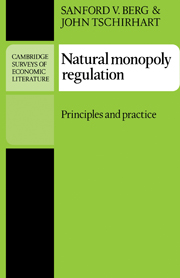Book contents
- Frontmatter
- Contents
- Preface
- 1 Introduction to regulatory economics
- Part I Optimal pricing and investment for natural monopolies
- Part II Natural monopoly regulation in practice
- 8 Regulation in practice: Why and how are firms regulated?
- 9 Models of regulatory constraints
- 10 Technological change under regulation
- 11 Partial regulation, deregulation, and diversification
- 12 Alternatives to traditional regulation
- References
- Author index
- Subject index
8 - Regulation in practice: Why and how are firms regulated?
Published online by Cambridge University Press: 06 November 2009
- Frontmatter
- Contents
- Preface
- 1 Introduction to regulatory economics
- Part I Optimal pricing and investment for natural monopolies
- Part II Natural monopoly regulation in practice
- 8 Regulation in practice: Why and how are firms regulated?
- 9 Models of regulatory constraints
- 10 Technological change under regulation
- 11 Partial regulation, deregulation, and diversification
- 12 Alternatives to traditional regulation
- References
- Author index
- Subject index
Summary
In this and subsequent chapters, we turn our attention from the principles underpinning why and how we should regulate price and entry in natural monopolies to examine the realities that dictate why and how we do regulate natural monopolies. As we shall see, on the one hand, realities often lead to compromised principles, and on the other hand, realities may sometimes be so complex that the principles seem to fall short of supplying adequate guidance to policy-makers.
This chapter provides an overview of the regulatory process, and Chapter 9 presents formal models that capture important features of that process. There we show how rate-base regulation for single-product and multiproduct firms can affect both the input and output mixes. Moreover, uncertainty, strategic behavior, and other features of the institutional environment further complicate outcomes in regulated industries. For example, automatic adjustment clauses and industry-wide regulatory constraints create incentives that lead to inefficiencies in levels of output and numbers of firms.
The remaining chapters also expand on points developed here in Chapter 8. The role of research and development in lowering costs and altering industrial configurations is surveyed in Chapter 10. In the context of a theoretical model of innovative activity, the chapter considers whether or not rate-base regulation biases the choice of technology toward capital-using techniques. Given the significant technological opportunities in energy and telecommunications, maintaining incentives for innovation is a key issue facing regulators. A further complication is that technological change can either reinforce or destroy the underlying justification for regulation.
Chapter 11 picks up this theme by examining partial regulation, deregulation, and diversification.
- Type
- Chapter
- Information
- Natural Monopoly RegulationPrinciples and Practice, pp. 283 - 322Publisher: Cambridge University PressPrint publication year: 1989



